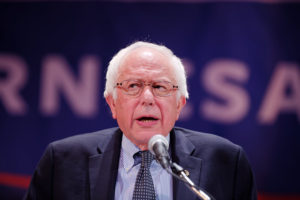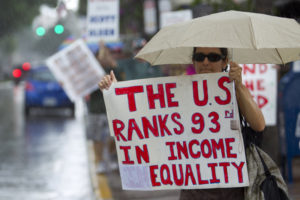Phony Populism Doesn’t Feed the Family
The 2016 election was supposed to be the one in which the interests of the non-elite got a hearing We still have two months to make it happen The 2016 election was supposed to be the one in which the interests of the non-elite got a hearing. The annual Labor Day parade in Pittsburgh. (John Heller / AP)
The annual Labor Day parade in Pittsburgh. (John Heller / AP)
The annual Labor Day parade in Pittsburgh. (John Heller / AP)
You would have thought that Labor Day 2016 would bring us a serious conversation about lifting the incomes of American workers and expanding their opportunities for advancement.
After all, we have spent the year talking incessantly about alienated blue-collar voters and a new populism rooted in the disaffection of those hammered by economic change.
But this is not the discussion we are having. Instead, we are enduring an attack-fest between Donald Trump and Hillary Clinton. Their strategies are entirely rational. Voters are understandably skeptical about politicians getting anything done, and both candidates know they have a better chance of encouraging negative votes rather than securing a positive mandate.
I’m sorry to say the media make things worse by preferring spectacle and confrontation to digging deeply into whether this plan to promote manufacturing or that idea for raising incomes will actually work. Clinton gave a very serious speech about mental health policy last week, but the coverage flowed to whether Trump was “softening” or “hardening” on immigration.
The truth is that Clinton has offered many more serious policy proposals for raising workers’ incomes than Trump has. Her website is full of ideas on expanding profit-sharing, a “Make it in America” initiative to promote manufacturing, plans on family leave, child care, cutting student debt and much more.
One of the banes of this campaign is the media’s temptation toward false balance: If a reporter says that Trump is not offering a lot of plans, he or she feels obligated to say either that Clinton is short on specifics, too, or that she may have a lot of plans but is not packaging them very well. But if the media doesn’t want to cover them, all the bright bunting in the world won’t matter.
In the meantime, Trump has effectively reduced his campaign to immigration and trade (plus “law and order”). He’s arguing that the problems faced by American workers will be magically solved if we throw millions of immigrants out of the country and if he gets a chance to negotiate much tougher trade deals.
It would be good to have a sane, fact-based debate about how immigration and trade affect incomes and job opportunities. But Trump’s vicious tone toward immigrants and his breathtaking lack of specificity about trade show that he’s more interested in exploiting these issues than thinking about them.
In the meantime, voices outside the campaign are trying to interject practical ideas that might help Americans whose incomes are lagging. The Opportunity Nation campaign will release a middle-of-the-road plan at the end of this week. Its main architects, Republican John Bridgeland and Democrat Bruce Reed, draw on ideas that have won support from both parties on expanding early childhood programs, increasing high school graduation rates, creating much broader opportunities for national service, and finding new ways to connect the 5.5 million Americans aged 16 to 24 who are disengaged from both school and work.
That there is nothing radical in the plan may be its virtue given how hard it will be to get anything through Congress if the voters again produce divided government.
Well worth more attention is the “10-20-30” initiative from Rep. Jim Clyburn, D-S.C. He would mandate that at least 10 percent of spending on federal programs go to counties where at least 20 percent of the population has lived below the poverty line for 30 years or more. Clinton has endorsed it, and House Speaker Paul Ryan has spoken favorably about it.
When it comes to both politics and our nation’s divisions around race, the plan has important virtues. The 488 counties include many that are predominantly white, as well as many that are predominantly African-American, Latino or Native American. Clyburn notes that the vast majority of counties that would benefit are represented by Republicans in Congress.
It’s also a brute fact that workers’ wages have declined or stagnated because the bargaining power of employees has been drastically undercut. A just-released study by the Economic Policy Institute showed that the weekly wages of non-union men without college degrees employed in the private sector would have been 8 percent higher in 2013 if union density had remained at 1979 levels.
And if older union models are out-of-date in some sectors, we need new ones such as those proposed by Sen. Elizabeth Warren, D-Mass., to strengthen the rights of Americans who work in the gig economy.
This was supposed to be the election in which the interests of the non-elite finally got a hearing. We still have two months to make it happen.
Your support matters…Independent journalism is under threat and overshadowed by heavily funded mainstream media.
You can help level the playing field. Become a member.
Your tax-deductible contribution keeps us digging beneath the headlines to give you thought-provoking, investigative reporting and analysis that unearths what's really happening- without compromise.
Give today to support our courageous, independent journalists.






You need to be a supporter to comment.
There are currently no responses to this article.
Be the first to respond.